This post may contain affiliate links. If you choose to make a purchase through these links, I earn a small commission at no cost to you. I do not promote anything I do not believe in or stand behind.
Young children love to pretend in every way. They enjoy learning new activities, too!
Every day, my young children see me do laundry. They sometimes like to help put the clothes in the washer and dryer, match socks while folding and my 4 year old likes to help put her clean and folded clothes away (sometimes 😉).
Setting up a laundry dramatic play space in your classroom or playroom is a great way to engage your little ones in pretend play! They learn about sorting, washing, drying, folding and ironing all while having fun pretending to be mom and dad doing the laundry.
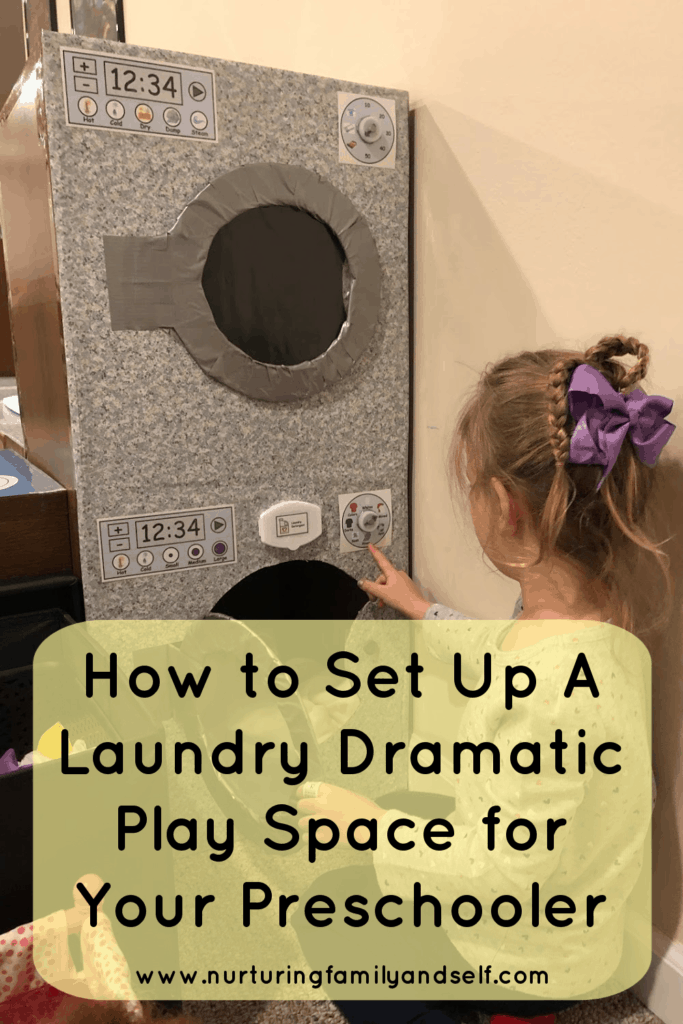
That’s why I decided to add a washer and dryer to our basement playroom. My preschooler loves to play with her baby dolls. She dresses them, feeds them and gives them a bath. Including a washer and dryer for her to wash her baby doll’s clothes was the perfect addition to the space. I wanted to extend her pretend play with baby dolls by adding a washer and dryer.
I didn’t want to spend a lot of money in the process of setting up a laundry dramatic play space for my children. Plus, my kiddos are just as happy playing with cardboard appliances as they are the real ones.
Since I just built a play kitchen from cardboard boxes, I decided to tackle the project of building a washer and dryer out of cardboard boxes. I chose to build a stacking one because it takes up less space, but there are many tutorials online for building side by side washer and dryers, too!
I’m so happy with how it turned out and my daughter loves playing with it. It didn’t take long to build and I was able to complete most of it during one naptime!
I want to teach you how to set up a laundry dramatic play space in your classroom or playroom. This will be an inviting space filled with learning and lots of fun!
What is my inspiration for building a washer and dryer from cardboard boxes?
Building a cardboard washer and dryer is an inexpensive way to engage your children in pretend play with lots of valuable learning in the process.
I did a search on Google for cardboard washer and dryers and used this DIY Cardboard Washer & Dryer Playset as my inspiration.
The Melissa & Doug Washer & Dryer design became my inspiration for the embellishments (buttons).
Before I built this washer and dryer, I created an even simpler version of a washer for my daughter. I took one large cardboard box, spray painted it white and cut out a door. I glued applesauce pouch caps onto the box for the buttons and drew bubbles on the door. My daughter enjoyed using it to clean her baby doll’s clothes, but it was quite large!
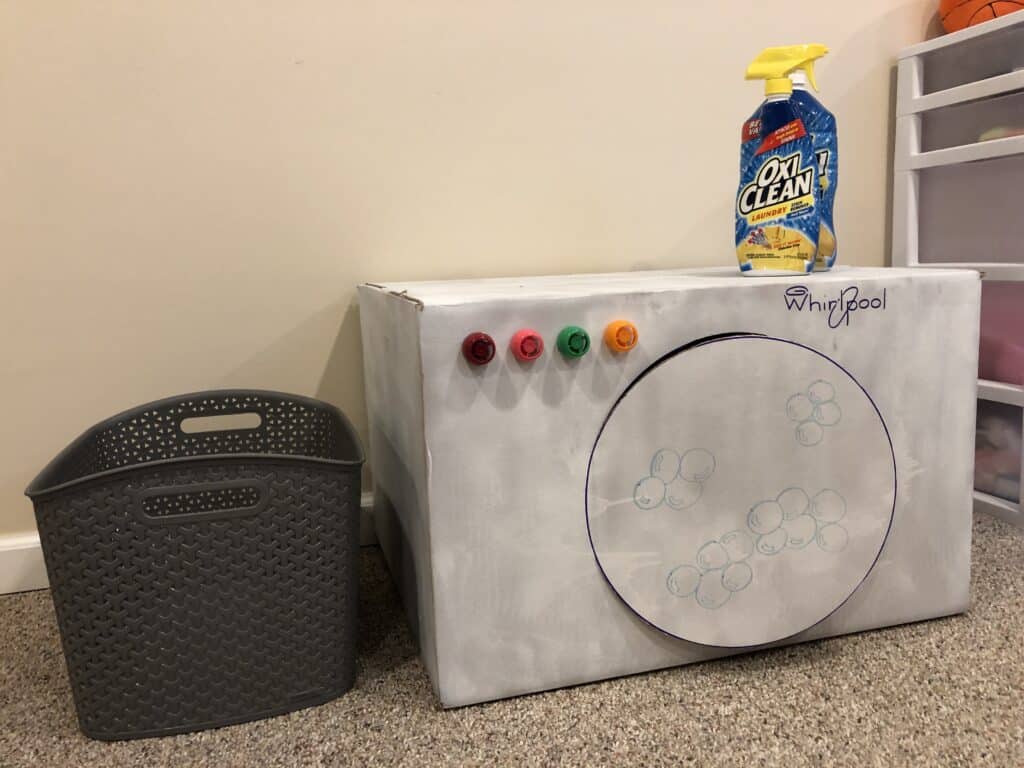
I decided I wanted something slightly smaller and wanted to include a dryer, too! That’s why I decided to build a new washer and dryer for my children!
What materials do I need to build a washer and dryer from cardboard?
The first thing I did was purchase the supplies I needed. I purchased two of these moving boxes from Target, but you can find them at other retailers or on Amazon. I needed more contact paper. I wanted the washer and dryer to match the play kitchen colors/theme so I got more of the same pattern from the Dollar Store. Other supplies I needed were a hot glue gun, duct tape, a box cutter and clear packing tape. You’ll also need two small boxes to put inside the washer and dryer. This prevents the clothes from being too deep. I used two large shirt gift boxes.
For the embellishments, I designed labels in Microsoft PowerPoint that I printed on white cardstock and laminated for durability. My four year old loves pretending to push the buttons for her load of laundry. You simply attach by covering completely in clear packing tape. This protects them from getting ripped!
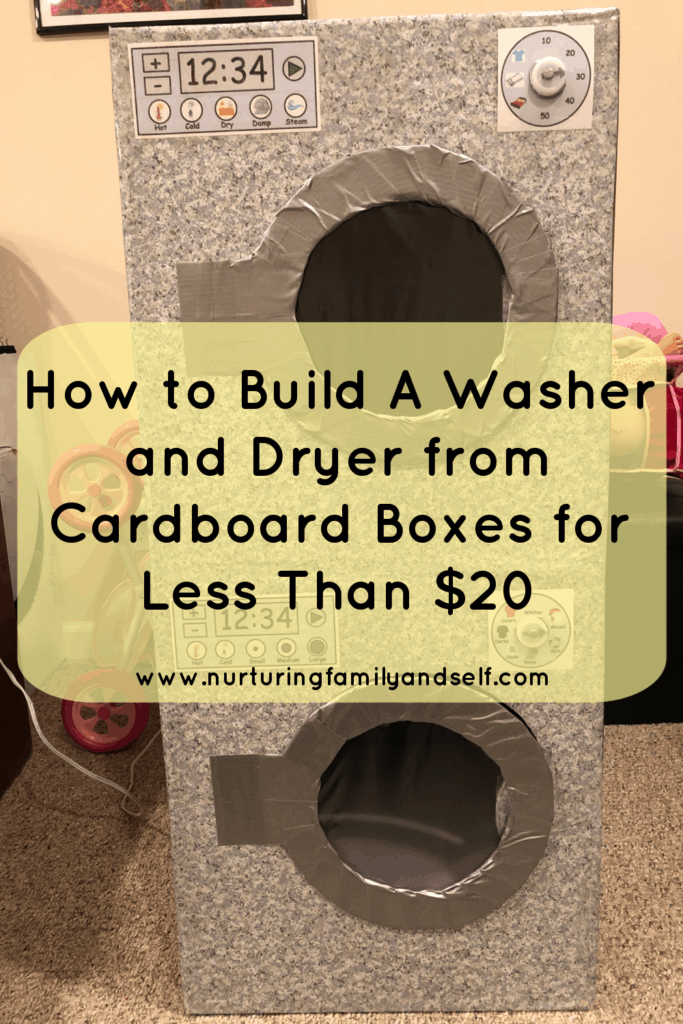
How do I build a washer and dryer from cardboard?
Assemble and Attach Cardboard Boxes
First, assemble and tape one side of each cardboard box together. Then use hot glue to attach boxes. Stack one on top of the other. I stacked them so the top and bottom of each box are on the sides. This way I can cut the doors for the washer and dryer on the solid side of cardboard.
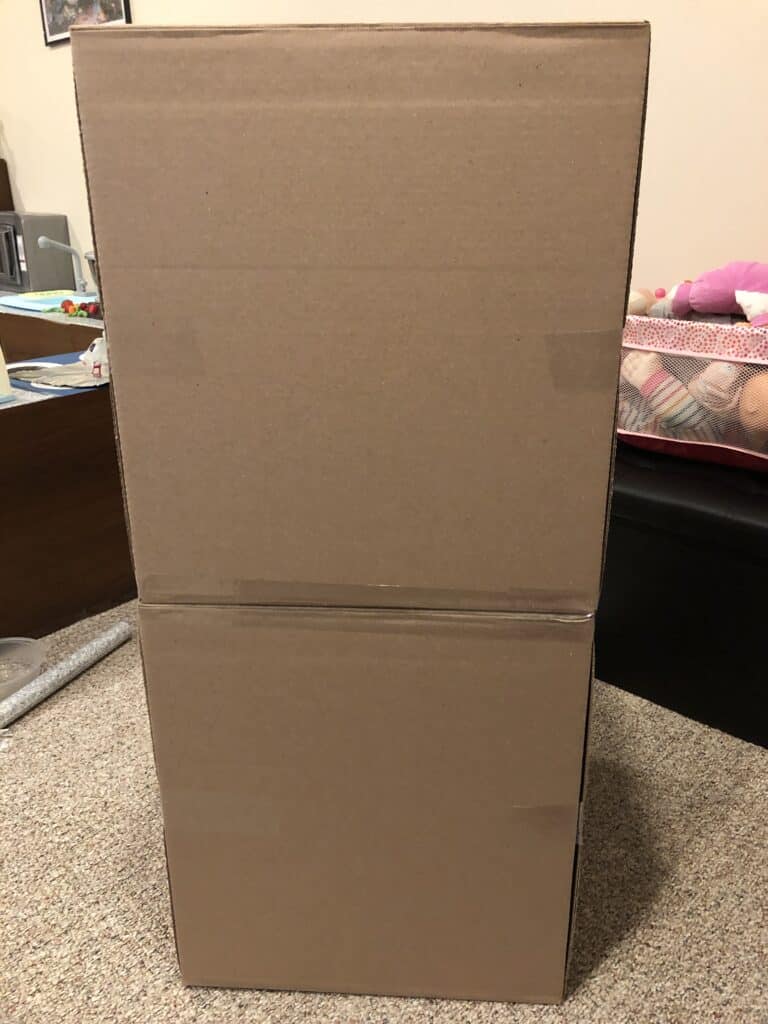
Take the smaller boxes and use hot glue to adhere to the inside bottom of each box. Next, tape the other side of each box shut. Now lay stacked washer and dryer down and reinforce it by taping where boxes are attached together. Wrap tape around all four sides.
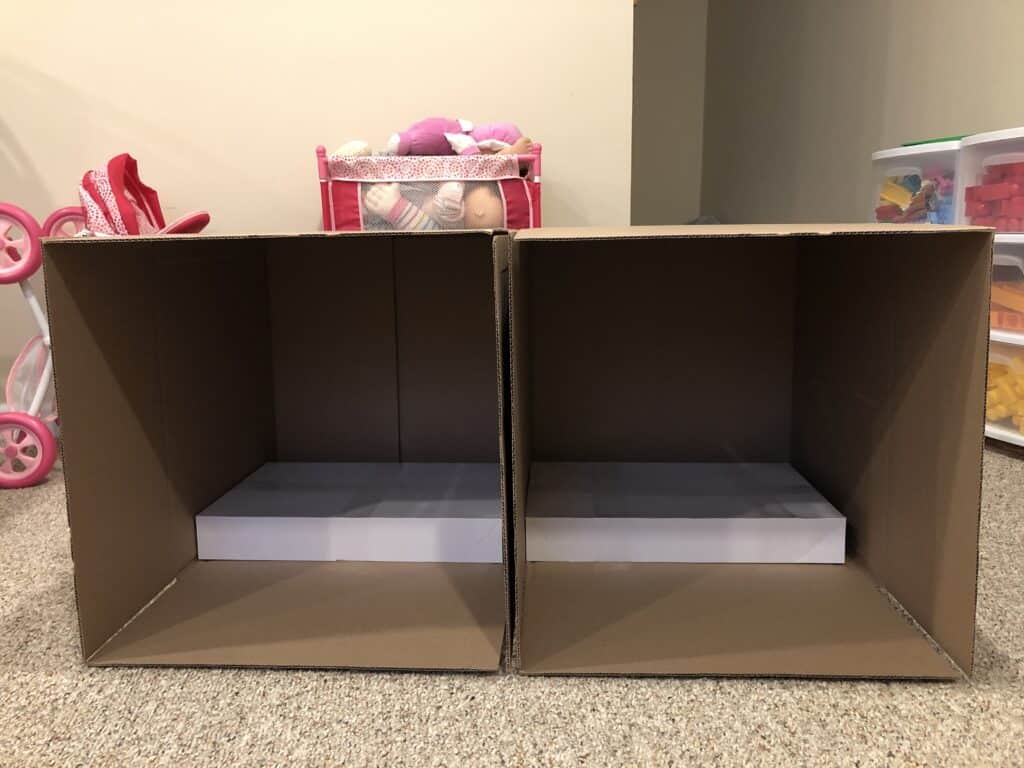
Cover the Washer and Dryer in Contact Paper
Next step is covering the washer and dryer in contact paper. This adds a layer of protection as the contact paper is wipeable. It also gives it a finished and unified look.
Starting with the top of the washer and dryer, wrap the cardboard slowly, smoothing out any bubbles as you go. Gradually pull the paper covering sticky side of contact paper away and flatten as you adhere it to the cardboard.
Wrap all the way around. Cut off, leaving about 1.5” of an overhang. You don’t need to worry about covering the bottom of the washer and dryer since it will not be seen. But a little overhang is a good idea!
Continue to wrap each side, starting at the top each time.
Reinforce Edges with Clear Packing Tape
Now you will reinforce all of the edges of the unit with clear packing tape. Use clear packing tape to cover where the contact paper ended on the bottom.
Cut Out the Doors for the Washer and Dryer
Now we are ready to cut out the doors. Find two circular items in your home to trace, one smaller than the other. You’ll want about 1.5” border on each door. You can use two different sized bowls, plates, or round cake pans.
Trace the biggest circle onto each box with a pencil. I tried to leave more space at the top than the bottom for attaching the buttons. Leave about a 2.5-3” margin between the door and the bottom of each box. This way the door clears the box you glued inside.
Center the smaller circle in the middle of the bigger circle and trace. The reason I am tracing a smaller circle is to create the glass opening, but you don’t have to do this step at all. You can simply trace a bigger circle and just cut that out.
Use a box cutter to cut out each door. I recommend cutting out the smaller circle first. Then cut out the door, leaving about 6” uncut on one side to create a hinge for the door to open and close.
The next step is completely optional! I liked the look of the metal frame around the doors so I wrapped each door frame with silver duct tape. I just wrapped all the way around, in small sections until the entire door frame was covered.
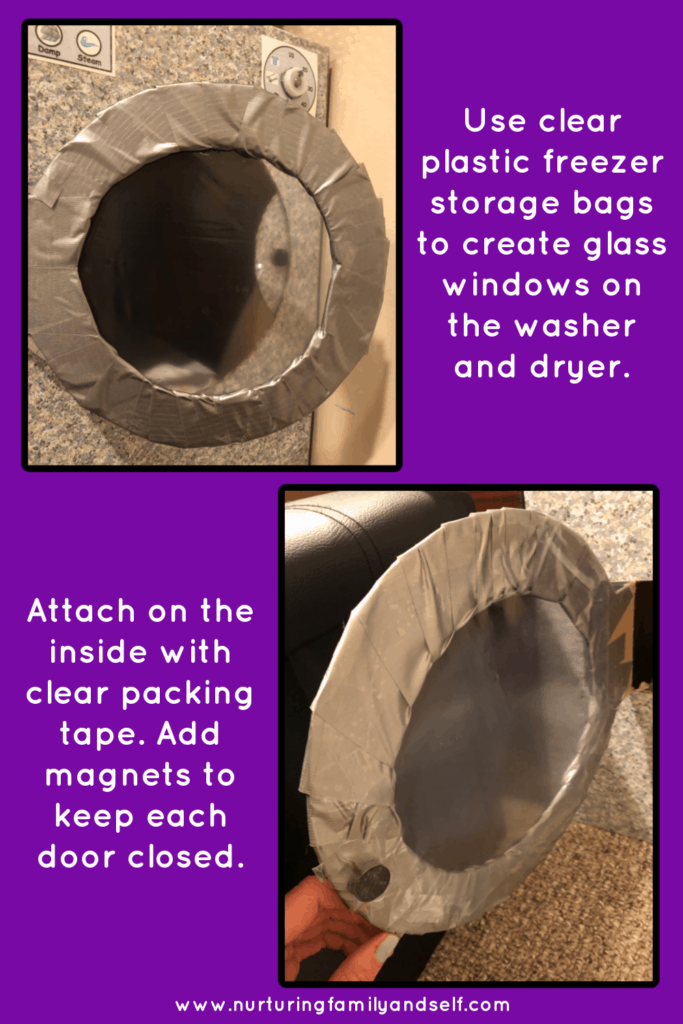
Create the “Glass” Windows
Now you are going to create the window. I used a clear plastic sheet protector, but a gallon-sized plastic storage bag works just as well!
Regardless of which one you are using, separate it so you have two pieces. One piece for the washer and one piece for the dryer.
Open each door, center the plastic covering, trimming any excess that may stick over the door. Then use craft glue to attach the plastic to the door. Draw a circle of glue around the door and stick the plastic covering on, pressing gently to make sure it adheres. The glue will dry clear so don’t worry about seeing the glue.
Reinforce the plastic covering by placing a piece of clear packing tape around the four edges. This covers the edges and prevents little hands from ripping it off.
It bothered me that the doors were staying open. To solve this problem, I took the piece of cardboard cut out from the middle of the door and glued it to the inside right front side with hot glue. Then attached these heavy duty magnets with hot glue.
Add Labels and Embellishments
It’s time to bring your washer and dryer to life with labels and embellishments. It’s so easy to create your own labels in Microsoft PowerPoint!
Drawing the buttons on the washer and dryer with a permanent marker is another option, too!
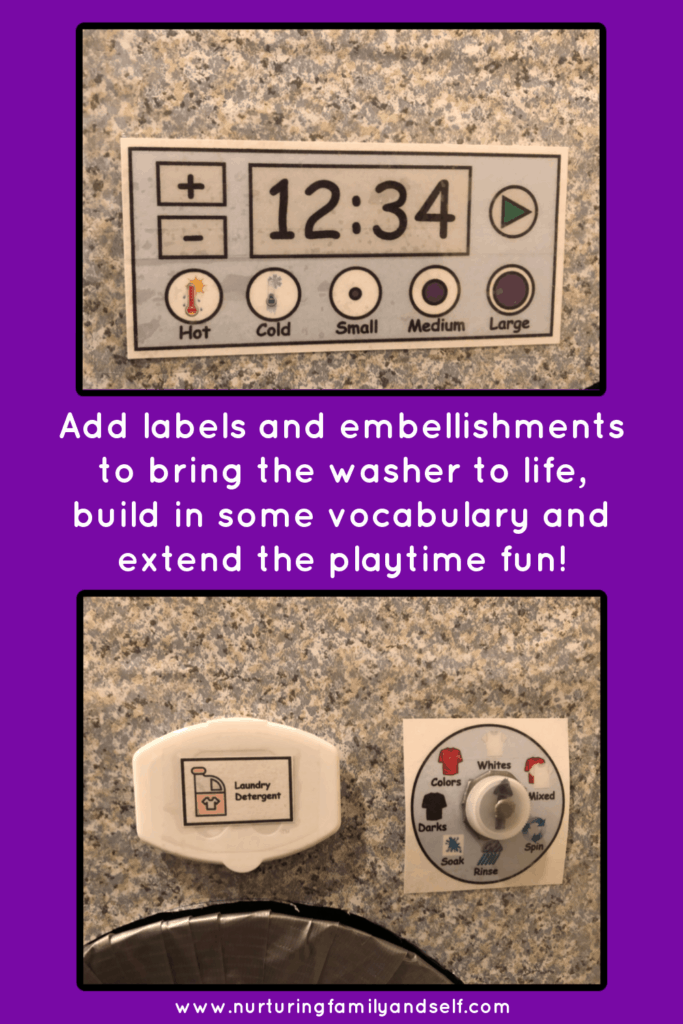
As I mentioned before, I used the Melissa & Doug washer and dryer design as my inspiration for the labels I created. The display for the washer includes a button for water temperature, load size, and start. The display for the dryer includes a button for drying temperature and different options like steam. There is also a circle dial for selecting the type of load being washed and amount of time for dryer.
Download the Laundry Day Dramatic Play Printable Pack – for free! Plus, get access to our entire library of resources 😁 Just click the image below to access our Resource Library and get your free printable!
First, I printed the sheet on white cardstock and laminated them for durability. Then I cut them out. I used a plastic water bottle cap to create a dial my little ones could turn. I drew an arrow on the top of the bottle cap with a black permanent marker. Then used a nail to punch a hole in the middle. I attached the bottle cap to each dial with a brass paper fastener so it would turn. I covered the brass fastener with duct tape so it blended in better with the overall look of the washer.
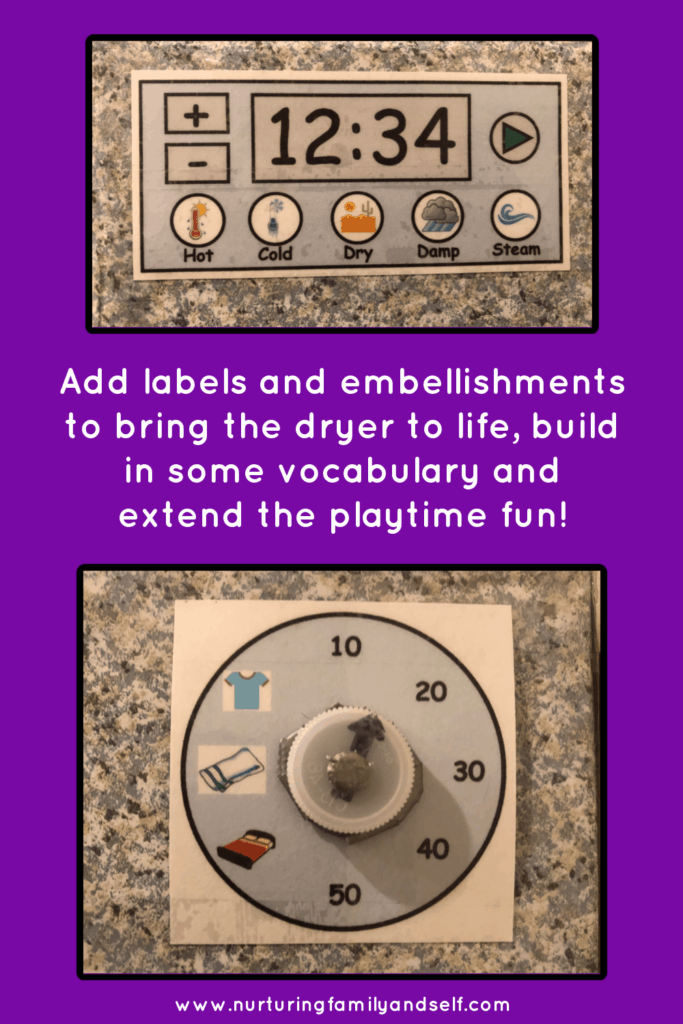
Now you attach the labels to the washer and dryer. I used white craft glue to adhere the displays to the appliances. Clear packing tape reinforces the edges so they don’t rip off.
I only used clear packing tape to attach the dials since they have the moveable knob. I put a piece of clear packing tape across the top, bottom and sides of each dial.
How do you set up a laundry area for pretend play?
You will need several laundry props to finish setting up your dramatic play space. Here is a list of props you will need to bring your laundry area to life and engage your kiddos in lots of fun pretend play:
- Clothesline
- Clothespins
- Laundry Basket
- Laundry Soap Bottle
- Stain Remover Spray Bottle
- Felt/Fabric Dryer Sheets
- Iron and Ironing Board
- Small Hangers
- Doll or Baby Clothes
You can actually find several of the above mentioned props in this cute laundry basket play set from Melissa & Doug. I love the laundry detergent bottle, laundry basket and dryer sheet box included. The realistic props will have your young children begging to do laundry!
Use a piece of string tied to two kid-sized chairs to set up a clothesline for hanging clothes to dry. You can also place two command hooks on a wall and attach the clothesline to each hook. Check out this cute laundry dramatic space in a preschool classroom.
Opening the clothespins is great fine motor activity for little ones. It helps strengthen the muscles in their hands, which is important for writing letters and numbers.
You can find small laundry baskets at the Dollar Store. I recommend getting two baskets to teach your child about sorting laundry. One basket for whites and one basket for colors. Use the labels included in my laundry day dramatic play printable pack to label each basket. Print each label on white cardstock, laminate for durability (or wrap in clear packing tape) and attach to each basket with binder rings.
Use a recycled laundry soap bottle that has been cleaned out really well for the laundry dramatic play. I made sure to rinse the bottle several times with hot water to guarantee all of the remaining laundry soap was gone. Then set it to dry really well before giving it to your child.
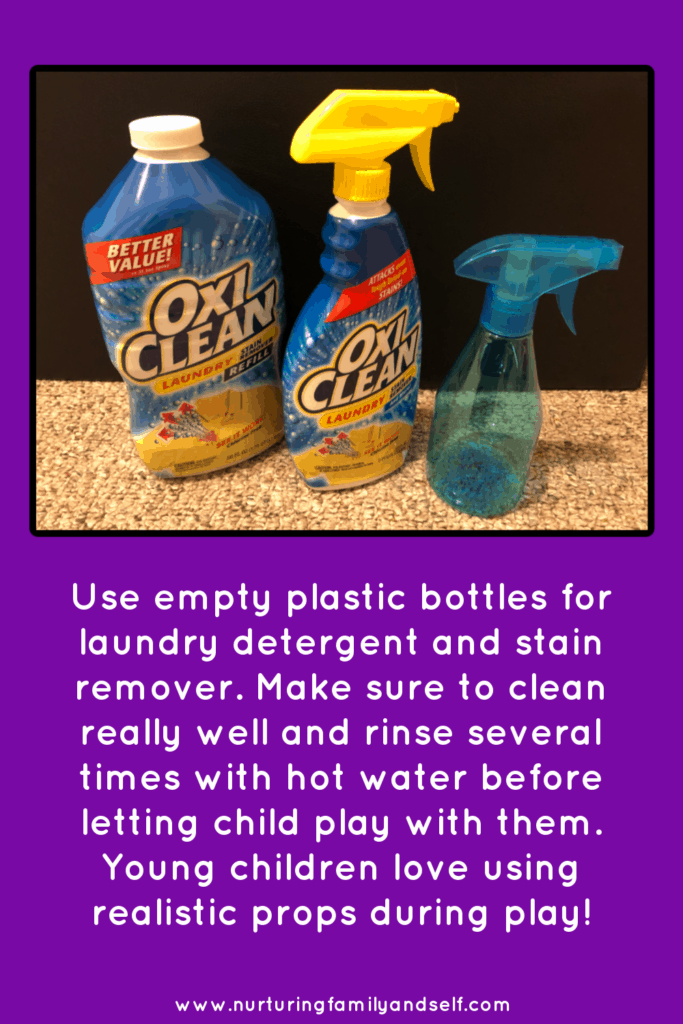
Create a laundry soap dispenser by attaching the opening from an empty baby wipes package. Use hot glue to adhere it to the washing machine. Attach a laundry detergent label to the top with clear packing tape over top of it.
Purchase a plastic spray bottle from the Dollar Store and use it as a stain remover.
Use pieces of white felt as dryer sheets, keeping them in an empty tissue box. Cut the white felt to 4×6 rectangles. Show your child how to throw one into the dryer after loading the clothes.
What are the benefits of a washer and dryer for child’s play?
One of the main benefits of adding a washer and dryer to your child’s play space is giving them the chance to imitate something they see the adults in their life doing every day. Young children love to pretend to be mom and dad. Plus, they learn the steps needed to complete a daily chore with the hope of helping mom and dad one day!
A lot of learning happens while your child is engaged in any form of pretend play. Playing with the washer and dryer and pretending to do the laundry opens the door for many learning opportunities. Here are all of the things your young child is learning while playing with his/her washer and dryer:
- Vocabulary
- Sequencing
- Language
- Matching
- Sorting
- Classifying
- Opposites
- Motor Skills
Building Vocabulary
While pretending to do the laundry, young children learn specific vocabulary words associated with laundry. They learn the names of the actions: separate, wash, dry, fold, and iron. They learn the names of the tools needed to do the laundry: washer, dryer, detergent, stain remover, dryer sheet, clothesline, clothespin, and basket. They learn descriptive words: dirty, clean, wet, dry, damp, warm, hot, and cold.
Sequencing Steps in A Process
Young children learn the steps taken to complete a load of laundry from start to finish. While playing, incorporating the words first, next, then, and last expands your child’s vocabulary and language skills. They learn to associate these words with the order of events. First I separate the laundry. Next I put the clothes in the washer. Then I dry the clothes in the dryer or on the clothesline. Last I fold and put away the clean clothes. So much vocabulary and language building for young children!
Matching, Sorting and Classifying
Matching, sorting and classifying are valuable skills for young children to learn. Sorting and classifying focuses your child’s attention on what is the same and different between two things, which is important for math learning.
While engaged in laundry dramatic play, your child classifies clothes as dirty or clean. He/she sorts the clothes by color. When folding the clean clothes, your child matches socks and sorts the clothes by type as he/she makes piles to put away.
Opposites
Young children learn about opposites when doing the laundry. The clothes are dirty/clean, wet/dry, and folded/unfolded. The laundry basket is full/empty. This is another way to expand your child’s vocabulary.
Fine and Gross Motor Skills
Fine motor skills are important for writing. Your child will turn the knob on the washer and dryer. Your child will also use clothespins to hang clothes on the clothesline. Opening the laundry detergent dispenser is another example of a fine motor activity.
Gross motor skills involve movements of the larger muscles in the arms, legs and body. Opening and closing the washer and dryer door is an example of a gross motor activity. Other examples include sorting clothes into laundry baskets, putting the clothes into the washer and dryer, folding the clean laundry and carrying/moving a laundry basket.
How do you extend play and learning with the washer and dryer?
Roll and Count the Clothes
In addition to the benefits listed above, your child can practice counting. Turn doing the laundry into a fun game. Roll a dice and have your child count out that many items of clothing to put in the washing machine. Depending on your child’s level and interest, use two dice. Then compare the two amounts by discussing which amount of clothing is greater. Similarly, take turns rolling a dice and folding the clothes. Fill two baskets with at least 15 clothing items. Roll a dice and fold the amount of clothes rolled. Whoever folds all of their clothes first wins the game.
Measure the Clothes
Using clothespins, have your child measure the length of a few items of clothing. Maybe a pair of pants, a shirt and a sock. Three items that are different lengths. After measuring each item, count the number of clothespins. Talk about the different lengths, discussing which item of clothing is longest and which one is shortest.
Beginning Sound Clothing Sort
Provide your child with a variety of clothing items in the laundry basket. Work with your child as you name each item of clothing and group together the items that begin with the same letter sound.
Seasonal Clothing Sort
Read a book with your child about seasons and weather. Then talk about how you wear different types of clothes during each season. Look through the clothing items in your laundry space and decide which season or type of weather you would wear it.
Pattern Clothing Sort
Sort the clothing items by color or pattern. Talk about whether the clothes have polka dots, stripes or no pattern at all. Clothes can also be sorted by type of fastener. Do the clothes have zippers, buttons or snaps? Do the clothes have pockets? Sort the clothes into two piles: ones with pockets and ones without.
Read Books About Laundry and Clothes
I am a huge proponent of reading books as part of our play and learning. Reading books about doing the laundry can inspire learning and set the stage for hours of play.
Young children love to act out their favorite stories and the titles I share below are perfect for sparking the imagination when it comes to doing laundry and visiting the laundromat.
Reading books with your child about any topic brings the two of you closer together, brings about conversation and exposes your child to a variety of language and vocabulary.
Here are some of my favorite books you can read with your child as part of your laundry dramatic play. Some are silly and fun to read. Some are informational. All of them are engaging for young children and ones they will want to read over and over and over again.
Mrs. McNosh Hangs Up Her Wash by Sarah Weeks is a wonderfully engaging and silly read aloud for young children. This rhyming story is about a woman who loves to hang up her wash on the clothesline, as well as a few other things.
No Clean Clothes by Robert Munsch is about a little girl named Lacey who hides her clothes and her mom doesn’t wash them. She needs one shirt to wear and her mom suggested a strange shirt from her grandmother to school.
The Day Jimmy’s Boa Ate the Wash by Trinka Hakes Noble is a hilarious story about what happens when the class goes on a trip to the farm. Things go crazy when one of the students brings his boa constrictor to the farm.
Laundry Day by Jessixa Bagley is a hilarious tale about two bored badgers who help their mother with the laundry by hanging the clean clothes on the clothesline. Once they finish hanging all the clothes, they decide to start hanging more things they find on the clothesline. Their mother comes home from the market and is shocked to see what the badgers have done.
Knuffle Bunny by Mo Willems is about Trixie, Daddy and Knuffle Bunny’s trip to the laundromat. Things take a dramatic turn when Trixie realizes that Knuffle Bunny was left behind at the laundromat. She fusses and tries to show Daddy how upset she is. By the time they get home, Daddy is very unhappy. The mix of black and white photographs and expressive illustrations is a neat feature of this picture book.
Henry Helps with Laundry by Beth Bracken will teach your little ones how to do the laundry. It explains each step Henry takes to help his mom with the laundry. He is a very good helper! He helps sort the clothes, put them in the washer and dryer, put the folded clothes into piles and put the clean clothes away.
Little Helpers Laundry Day Sort & Play is an interactive board book with felt clothing and soft sections on each page that the felt will stick to. Your young children will learn how to help with the laundry and how to get dressed.
A Pocket for Corduroy by Don Freeman is a sequel to Corduroy. Lisa and her mom go to the laundromat to do laundry. Her beloved bear, Corduroy, searches for a pocket. His adventure is filled with the sights, sounds, smells and dangers of the laundromat. But, Lisa and Corduroy get separated. Corduroy ends up locked inside the laundromat all night long. In this cute story, young children learn how Corduroy gets his pocket and what he puts inside.
Conclusion
I hope that this post is helpful when setting up a laundry dramatic play space for your children or students. Building a washer and dryer out of cardboard is an easy and inexpensive way to engage your young children in hours of pretend play. Incorporating several props like an iron, ironing board, clothespins and a clothesline extends the play even more. So much learning happens when pretending to do the laundry. Don’t forget to pair your child’s play with one of the wonderfully engaging picture books I share in this post!

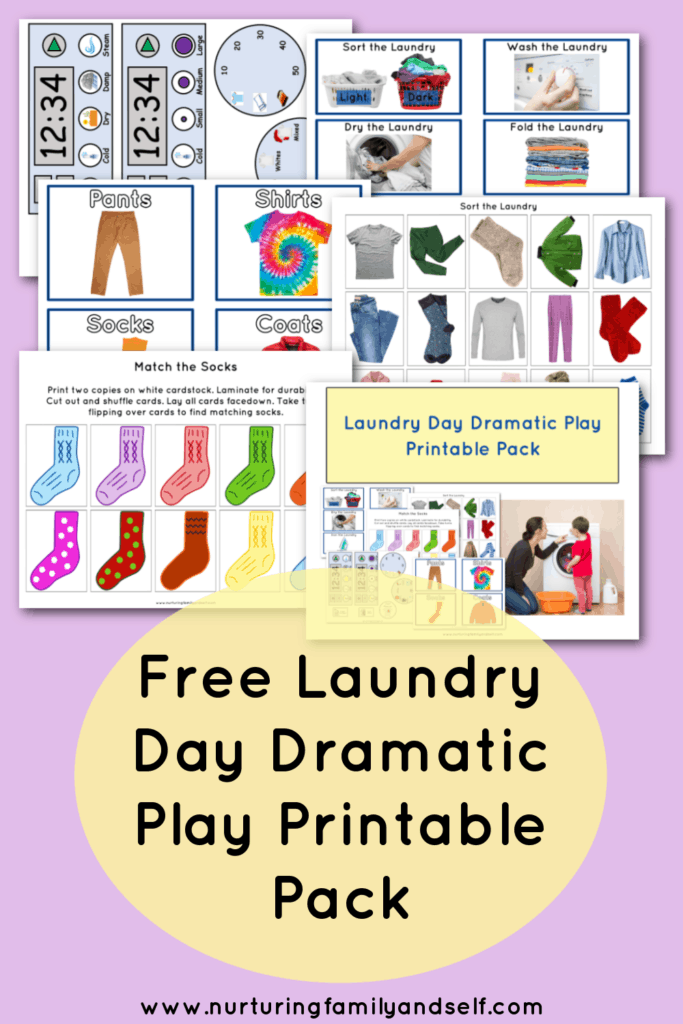






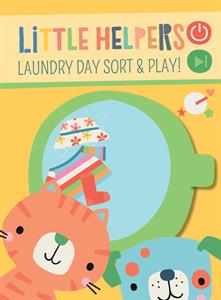

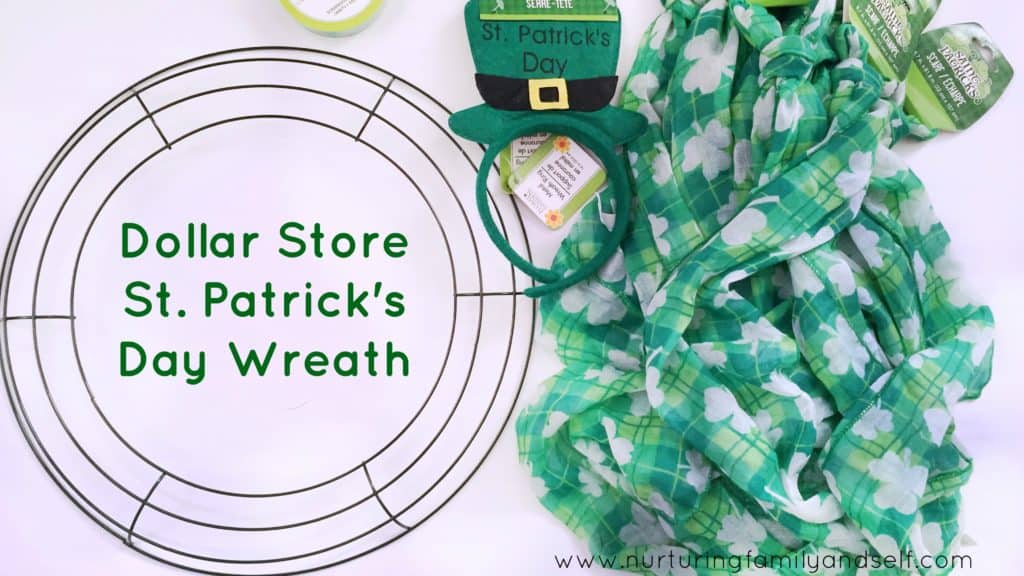
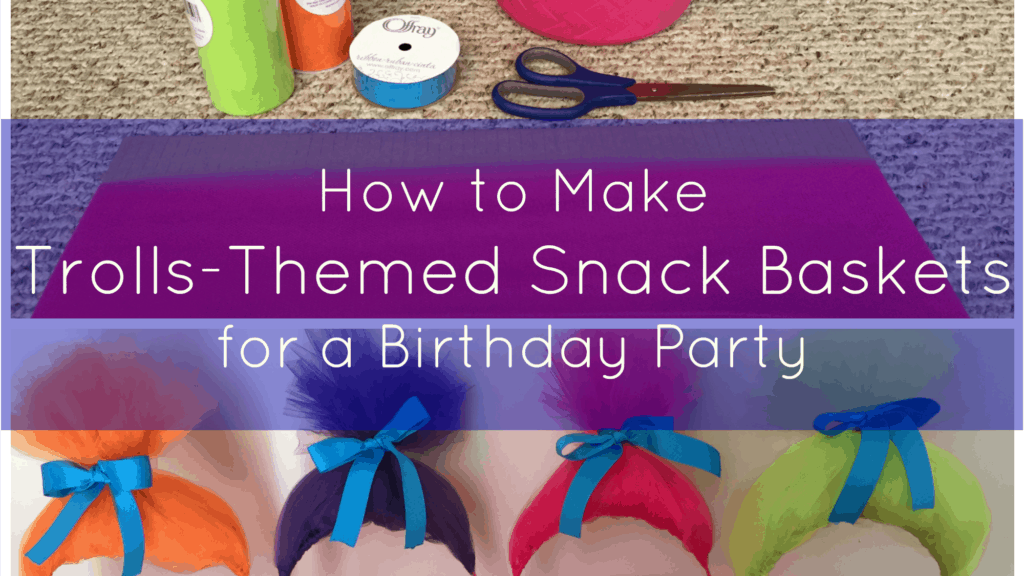
Please send me this laundry I’m a Prek teacher currently working on the unit.
Thank you for your interest in this article and the Dramatic Play Activity Pack! Just click on the image in the middle of the post to grab the dramatic play pack. Let me know if you have any trouble! Thanks 🙂
Hi I signed up and I didn’t receive an email please send. Thank you
Email sent! Thank you so much for letting me know!
Please send me this laundry I’m a Prek teacher currently working on the unit. Thank you
Thank you so much for your interest! I sent you an email with the link to the file for the Laundry Printable Play Pack. Let me know if you need anything else.
Could you please send me the laundry printable pack? I clicked on the picture and signed up for emails but, did not gain access to the file. I am just getting started on this study. Thank you
Thank you for letting me know that the email link did not work for you. I have sent the link to you in an email. Let me know if you need anything else and thank you for stopping by!
The email didn’t include a link can you please email it. 🙂
I apologize that the email didn’t’ arrive in your inbox. I will send it to you again. Thank you for your interest in the Laundry Printable Play Pack.
Please send me the link for the laundry printable pack. I clicked on the link but did not receive the pictures. Thanks so much. I can’t wait to start this unit.
Please check your inbox. I just sent a new email with the link to the printable. Thank you for letting me know it didn’t arrive in your inbox.
Hello! I signed up for your newsletter, but the link is not working for me. Could you please send? beckylewis1996@yahoo.com. Thank you!
-Becky
I resent the email with the link. Let me know if there is anything else I can help you with! Thank you so much for stopping by!
Hello,
I have signed-up for emails and received a Welcome email, but did not receive the Laundry Pack. How do I access it?
Thank you!
I apologize that an email didn’t get sent with the Laundry Pack Printable. I will send you an email with a link to the file. Thank you for stopping by and showing interest and please let me know if you need anything else 🙂
Hi, can you please send me the laundry pack printable please. I received your welcomed email but nothing else.
Please check your inbox! I just resent the link to the printable pack 🙂
Hello,
I have signed-up for emails and received a Welcome email, but did not receive the Laundry Pack. How do I access it?
Thank you!
Hello! Thank you for your interest in the Laundry Printable Activity Pack. I apologize that the email didn’t arrive in your inbox. I will send it again. Thank you for letting me know and let me know if there is any other activities you are interested in 🙂
Hello! I signed up for the emails but didn’t receive the free pack! Can you please send me the link? Thank you so much!
Hello! Thank you for letting me know it did not come to your inbox! I just resent the link to the packet to you 🙂 Please check your email and let me know if you still don’t receive it. Thanks for stopping by to visit and for your interest in the activity!
I subscribed and got the email that I did but didn’t receive the printable packet. Did I do something wrong?
Hello! Thank you for your interest in the printable packet. I will send you an email with a link to the packet. I apologize that it did not come to your inbox. Thanks for letting me know and for your interest 🙂
I did not receive the freebie in my email or a password to use the resource library.
Good morning! Thank you for letting me know! Please check your inbox and let me know if you still don’t receive it 🙂
Hi i signed up but did not receive the laundry pack. Was prompted to sign up again each time I clicked the image.
I apologize that the laundry pack did not make it to your inbox. Please check your email. I will send it again. Let me know if it doesn’t work for you 🙂
hi,
I have signed up but didn’t receive the link for the printable pack. May I have the link? thank you so much.
Thank you for letting me know you did not receive the printable pack! Please check your email as I resent the link 🙂
Hi I signed up and I didn’t receive an email please send. Thank you
Thank you for letting me know! Please check your email. I just resent it to you 🙂
I signed up to receive the laundry printable but did not get a link via email. I would love to use this in my PreK class as we do a study on clothing. Thank you for you help!
Thank you so much for stopping by and for your interest in the laundry printable play pack. I have resent you an email with a link to the free printable. Let me know if there is anything else you need!!
Hello, I love the laundromat bundle. I clicked on the link and received an email but there wasn’t the file for the laundromat in the email Can you please allow access to it? Thanks
Thank you for letting me know you didn’t receive the printable. I have resent an email with a link to the printable. Let me know if you need anything else!
I also did not receive the pack, just the welcome email!
I have resent an email with the link to the printable 🙂 Thank you for letting me know you didn’t receive it!
I did not receive the link to get the laundry pack, could I please get some help with that?
Email sent! Thank you so much for stopping by and letting me know!
I signed up to get the free laundry printable but I never received the link for it
Hello Stacey! I resent an email with a link to access the free printable on February 15th. Please check your spam folder in case it went there.
Hi, I am prek3 teacher currently working on clothes unit. Could you please send me the link to the laundry labels. I tried clicking on the picture but nothing happened.
thank you!
I sent you an email with the link! Enjoy 🙂
Hi there, this looks brilliant for the laundry set up – I clicked the image and signed up but only received the welcome email but no code or link. I’d really appreciate it if you could email it to me, thanks so much, Jenny
Thank you so much for stopping by! I just sent you an email with the link to the printable. I hope you enjoy using it!